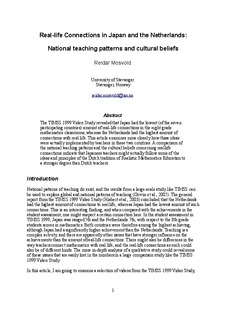| dc.contributor.author | Mosvold, Reidar | |
| dc.date.accessioned | 2013-04-23T13:11:46Z | |
| dc.date.available | 2013-04-23T13:11:46Z | |
| dc.date.issued | 2008 | |
| dc.identifier.citation | Mosvold, R. (2008) Real-life connections in Japan and the Netherlands : National teaching patterns and cultural beliefs. International journal for mathematics teaching and learning, July 2008, 1-18 | no_NO |
| dc.identifier.uri | http://hdl.handle.net/11250/185486 | |
| dc.description | www.cimt.plymouth.ac.uk/journal/mosvold.pdf | no_NO |
| dc.description.abstract | The TIMSS 1999 Video Study revealed that Japan had the lowest (of the seven
participating countries) amount of real-life connections in the eight grade
mathematics classrooms, whereas the Netherlands had the highest amount of
connections with real life. This article examines more closely how these ideas
were actually implemented by teachers in these two countries. A comparison of
the national teaching patterns and the cultural beliefs concerning real-life
connections indicate that Japanese teachers might actually follow some of the
ideas and principles of the Dutch tradition of Realistic Mathematics Education to
a stronger degree than Dutch teachers. | no_NO |
| dc.language.iso | eng | no_NO |
| dc.publisher | Centre for Innovation in Mathematics Teaching | no_NO |
| dc.subject | mathematics | no_NO |
| dc.subject | teaching | no_NO |
| dc.subject | Japan | no_NO |
| dc.subject | the Netherlands | no_NO |
| dc.title | Real-life connections in Japan and the Netherlands : National teaching patterns and cultural beliefs | no_NO |
| dc.type | Journal article | no_NO |
| dc.type | Peer reviewed | no_NO |
| dc.subject.nsi | VDP::Social science: 200::Education: 280 | no_NO |
| dc.source.pagenumber | 1-18 | no_NO |
| dc.source.journal | International journal for mathematics teaching and learning | no_NO |
